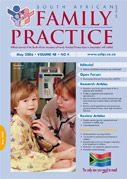Pertussis – An update for general practice
Abstract
Although there has been a global decline in the incidence of pertussis in the past four decades, the incidence has increased in developed countries, particularly in preteens, adolescents and adults. These groups provide a major reservoir of the disease for vulnerable unimmunised or incompletely immunised infants. This trend has not yet been documented in South Africa. In young infants, the diagnosis is made on the basis of clinical features. Older age groups do not usually show the typical clinical picture, leading to misdiagnosis and underreporting. The culture of Bordetella pertussis from the posterior nasopharynx remains the gold standard for diagnosis but laboratory diagnosis is complex and unavailable in most settings. Erythromycin, instituted early in the course of illness, remains the treatment of choice although there is now good evidence for the use of other macrolides, particularly in the neonate. Immunisation of young infants remains the best preventative method against the disease. Due to the re-emergence of the disease in older age groups, developed countries are recommending booster vaccines in adolescents. (SA Fam Pract 2006;48(4): 44-46)
Issue
Section
CPD
By submitting manuscripts to SAFP, authors of original articles are assigning copyright to the South African Academy of Family Physicians. Copyright of review articles are assigned to the Publisher, Medpharm Publications (Pty) Ltd, unless otherwise specified. Authors may use their own work after publication without written permission, provided they acknowledge the original source. Individuals and academic institutions may freely copy and distribute articles published in SAFP for educational and research purposes without obtaining permission.

